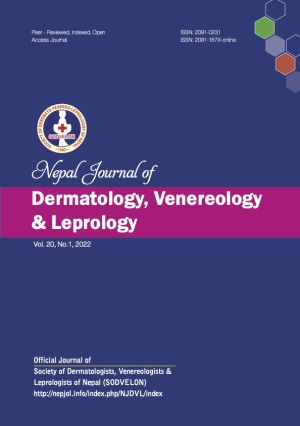Study of Correlation of Severity and Quality of Life in Patients with Congenital Ichthyosis
DOI:
https://doi.org/10.3126/njdvl.v20i1.39391Keywords:
Congenital ichthyosis, Disease severity, Quality of LifeAbstract
Introduction: Congenital ichthyosis is a disorder of cornification of skin with various cutaneous symptoms. Quality of life is a subjective perception of patients regarding their disease status and treatment received. Dermatological disorders have poor quality of life associated with them as any other systemic disease.
Objective : The present study was conducted to assess the quality of life among patients of congenital ichthyosis, so that suitable remedial measures may be devised based on the same.
Materials and Methods: It was a hospital based cross-sectional study with total 120 patients enrolled for study duration of one year .Children’s Dermatology Quality Life Index (CDLQI) questionnaire was used to assess the quality of life among patients. Global disease severity scale and VAS scale for severity of ichthyosis was used along with recording of socio-demographic details.
Results: With a response rate of 87%, the sample size comprised of 104 subjects, aged between 0-15 years. Females outnumbered the sample by more than 2/3rd. ‘Symptoms and feelings’ was the most affected domain in the CDLQI. Itching, female gender and presence of scales were significant predictors of poor quality of life scores.
Conclusion: The present study shows the epidemiological correlation of patients with congenital ichthyosis and the predictors of poor quality of life score. Regular subjective assessment of quality of life among patients should be included in routine clinic visits, as counselling plays a very important role in these patients.
Downloads
Downloads
Published
How to Cite
Issue
Section
License
Copyright (c) 2022 Society of Dermatologists, Venereologists and Leprologists of Nepal

This work is licensed under a Creative Commons Attribution 4.0 International License.
Copyright on any research article is transferred in full to Nepal Journal of Dermatology, Venereology & Leprology upon publication. The copyright transfer includes the right to reproduce and distribute the article in any form of reproduction (printing, electronic media or any other form).




